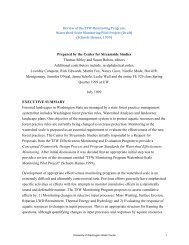Copyright 2012 Aileen M. Echiverri-Cohen - University of Washington
Copyright 2012 Aileen M. Echiverri-Cohen - University of Washington
Copyright 2012 Aileen M. Echiverri-Cohen - University of Washington
You also want an ePaper? Increase the reach of your titles
YUMPU automatically turns print PDFs into web optimized ePapers that Google loves.
education. Table 8 shows zero-order correlations among measures over time. Table 9 displays<br />
unstandardized regression coefficients (В), and standard errors <strong>of</strong> variables for change from pre-<br />
treatment to post-treatment. Only older age predicted changes in AB from pre- to post-treatment<br />
at lag 4: F(1, 33.85) = 4.95, p < .05, d = 0.76; B = .002, SE = .001, t(33.85) = 2.22, p < .05; such<br />
that older individuals with PTSD showed slower changes in inhibition from pre- to post-<br />
treatment. Contrast statements showed that for each additional year rate <strong>of</strong> improvement in<br />
inhibition slowed down (Lag 4: M = -.05, SE = .04). In contrast, gender, and education were<br />
weakly related to changes in inhibition, either for AB or PPI, from pre- to post-treatment. Thus,<br />
older age, but not gender or education, was a predictor <strong>of</strong> slower improvements in inhibitory<br />
functioning over the course <strong>of</strong> therapy.<br />
DISCUSSION<br />
Inhibition is implicated as a key mechanism <strong>of</strong> change because <strong>of</strong> the putative inhibitory<br />
effects <strong>of</strong> exposure therapy and selective serotonergic reuptake inhibitors in reducing chronic<br />
fear responses in PTSD. Despite this, little work has been done in comparing inhibitory changes<br />
associated with treatment response in these treatments. This is the first study to directly examine<br />
changes in basic inhibitory processes in PTSD from pre- to post-treatment, using these therapies.<br />
Notably, the present findings point to potential differential mechanisms <strong>of</strong> treatment response for<br />
exposure therapy and SSRIs. Specifically, individuals that showed greater reduction in PTSD<br />
symptoms from PE showed a faster increase in inhibition measured by attentional blink from<br />
pre- to post-treatment than those treated with SER, potentially highlighting the role <strong>of</strong> the<br />
alteration <strong>of</strong> temporal attention inhibition in exposure therapies. Generally, different effects were<br />
found for attention blink and pre-pulse inhibition. The AB paradigm showed improvements <strong>of</strong><br />
inhibition from pre- to post-treatment, arguing for common factors associated with improved<br />
40
















